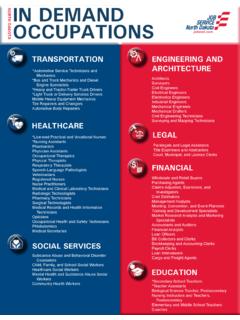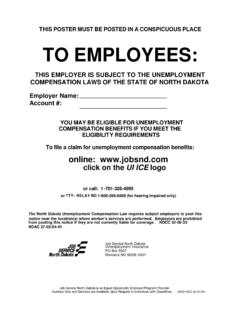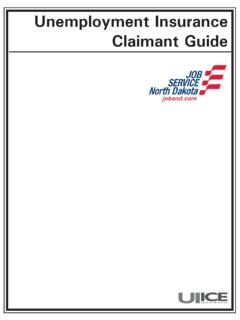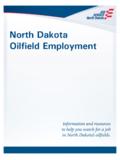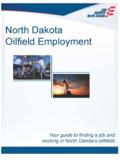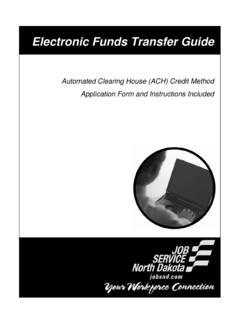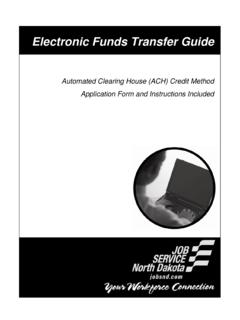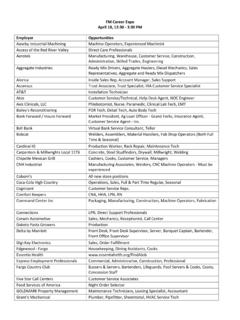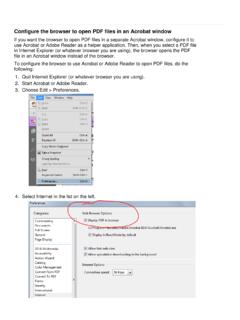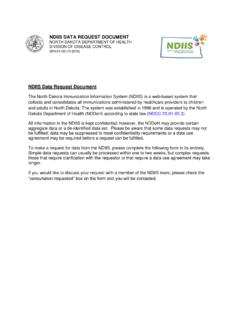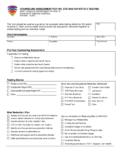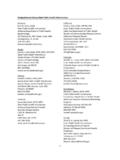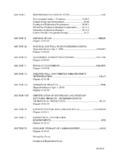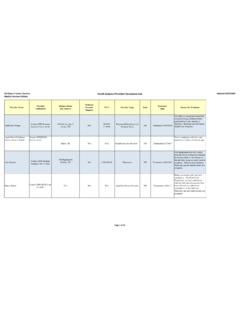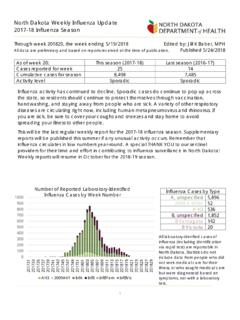Transcription of To The Employer - Job Service North Dakota
1 Unemployment Insurance Employer Account System Employer s Handbook For the Unemployment Insurance Program in North Dakota To employers .. 1 Overview .. 3 What is the Purpose of the Unemployment Insurance Program? .. 3 Definitions .. 5 Responsibilities of Job Service North Dakota Unemployment Insurance Tax Area .. 8 Unemployment Insurance Tax .. 9 Who is Subject to North Dakota Unemployment Compensation Law? .. 9 Employer Account Number .. 10 Covered Wages .. 10 Payments not Considered Wages .. 10 Excluded Employment .. 11 Corporate Officer/LLC Manager Exemption .. 12 Chart of Covered and Exempt Wages .. 13 Localized and Multi-State Employment .. 14 Reporting and Records .. 15 Records to be Kept by an Employing Unit .. 15 Poster to be Displayed by Employer .. 16 Completion of Quarterly Reports .. 16 Taxable Wages .. 17 Excess Wages .. 17 Example Showing Calculation of Total, Taxable, and Excess Wages.
2 17 Quarterly Report Due Dates .. 17 Online and Electronic Reporting of Quarterly Contribution and Wage Data .. 18 Separate Contribution Reports for Different Business Units .. 18 Correction of Quarterly Reports .. 19 Paying Unemployment Contributions Electronically .. 19 Late Reports/Incomplete Reports/Illegible Reports Penalty and Interest .. 20 Penalty for Late, Incomplete, or Illegible Reports .. 20 Interest .. 20 Delinquent Reports Effect on Contributions .. 20 Collection of Delinquent Reports and Contributions .. 21 Notifying Job Service North Dakota of Changes .. 21 Construction Projects Subject To Bonding Requirements .. 22 Determining Your Contribution (Tax) Rate .. 23 New Employer Contribution (Tax) Rates .. 23 Experience Rated Employer Contribution (Tax) Rates .. 23 Experience Rating Process .. 23 Contribution (Tax) Rate Calculation Process.
3 23 Tax Rate Schedule Determination .. 24 Employer s Tax Rate Determination .. 24 Voluntary Contributions .. 24 Transfer of an Employer s Experience Rating History to a Succeeding Employer .. 25 Mandatory Transfer .. 25 Acquisition of the Entire Business .. 25 Acquisition of Part of a Business .. 25 Anti-Suta Dumping Legislation .. 26 Staffing services .. 27 Merged Accounts .. 27 When the Successor is an Existing Employer .. 27 When a New Employer Acquires Two or More Existing employers .. 27 Unemployment Insurance Financing Options .. 28 Contributing Method (Tax-rated Method) .. 28 Special Financing Options for Government Entities, Non-Profit Organizations, and Indian Tribes .. 28 Changing Payment Method .. 29 Inactivation of Account .. 30 Termination of Liability .. 30 Federal Unemployment Tax Credit .. 31 Audits of Employer Records .. 31 Unemployment Insurance 32 Determination of Eligibility.
4 32 Amount of Unemployment Insurance 32 Basic Eligibility Requirements .. 33 Notification to Employer /Prompt Appeal .. 33 Charges to an Employer s Account .. 35 Statement of Benefits Paid .. 35 Disqualifications .. 36 Voluntary Quit .. 36 Misconduct .. 36 Labor Dispute .. 36 Refusal to Accept Suitable Work .. 37 Appeals .. 38 Time Limit .. 38 Hearing .. 38 Controlling Unemployment Insurance Costs .. 39 Stabilize Employment .. 39 Minimize Account Charges .. 39 Maintain a Stable Tax Rate .. 40 Information, Forms, and Assistance .. 41 Unemployment Insurance Field Representatives .. 42 Our Mission Job Service North Dakota provides customer-focused services to meet the current and emerging workforce needs of the state. This handbook has been prepared to provide a simplified explanation of the taxing and benefit provisions of North Dakota Unemployment Compensation Law and is not meant to be the sole source of unemployment insurance information, nor is it a legal document.
5 This manual does not take precedence over the unemployment insurance law or regulations. 1 | P a g e TO employers The efficient administration of North Dakota s Unemployment Compensation Law depends, to a large extent, on the cooperation between Job Service North Dakota and you, the Employer . In order to administer the program, Job Service North Dakota requires certain information from you periodically (such as quarterly contribution and wage reports) upon request. This handbook is designed to help you more clearly understand the basic provisions of North Dakota Unemployment Compensation Law and your rights and responsibilities under that law. By reading this publication carefully, and using it as a reference, you may save yourself time, effort, and money. For example, if you file your contribution and wage reports on time, you will avoid penalties and interest.
6 If you exercise your right to protest the payment of unemployment insurance benefits to a former employee, you may be able to protect your account from benefit charges that affect your tax rate. This handbook contains a variety of information addressing tax provisions, claims for benefits, payment of benefits, and forms for the Unemployment Insurance Program. It is designed to provide information of a general nature and is not intended to replace laws or regulations that govern the Unemployment Insurance Program or other programs. This handbook is subject to change at any time as a result of law revisions, administrative review decisions, court decisions, federal requirements, and department procedural changes. If your question is not answered in this handbook, contact the Unemployment Insurance Field Representative in your area.
7 A complete listing of Job Service Customer Service Offices, forms, and pertinent information regarding the Unemployment Insurance Program are available at Thank you for requesting, reading, and using this handbook as a reference. We look forward to a mutually beneficial relationship with you, a North Dakota Employer . 3 | P a g e OVERVIEW WHAT IS THE PURPOSE OF THE UNEMPLOYMENT INSURANCE PROGRAM? The purpose of the Unemployment Insurance Program is to provide temporary, partial wage replacement to individuals who have become unemployed through no fault of their own. Unemployment insurance benefits help the unemployed protect their financial health while cushioning the impact of economic downturns. employers pay unemployment insurance taxes under two tax systems, federal and state. Taxes paid to the federal government under the Federal Unemployment Tax Act (FUTA) are used to fund the administrative costs of the federal and state programs, to finance a variety of services provided through the network of state employment security agencies, and to cover the federal costs involved in extended benefits.
8 Taxes paid to the state government are used to pay unemployment insurance benefits to unemployed workers who have become unemployed through no fault of their own. The basis of North Dakota s tax program is simple: the more benefits paid to an Employer s former employees or the greater the Employer s exposure to the risk of unemployment, the more taxes the Employer will pay. Unemployment insurance tax payments are placed into the Unemployment Insurance Trust Fund and are used only for the purpose of benefit payments to qualified unemployed individuals. Each year, Job Service North Dakota analyzes each Employer s experience in the program (each Employer s separate account) and assigns the tax rate set by law for that level of experience. 5 | P a g e DEFINITIONS Account Number: An identification number assigned by Job Service North Dakota to each Employer liable under the North Dakota Unemployment Compensation Law.
9 Appeal: A request for review of a determination or decision issued by Job Service North Dakota . Appeals Referee: The officer at an appeals hearing resulting from an appeal of a determination or decision. Average Annual (Taxable) Payroll: The annual payroll for the 12-month period immediately preceding the computation date for an Employer who has been liable for at least 12-months but less than 24-months. The average of the annual payrolls for the last two 12-month periods immediately preceding the computation date for an Employer who has been liable for at least 24-months but less than 36-months. The average of the annual payrolls for the last three 12-month periods immediately preceding the computation date for an Employer who has been liable for 36-months or more. Base Period: The first four of the last five completed calendar quarters immediately preceding the effective date of an unemployment insurance benefit claim.
10 Benefit Charges: The amount of benefits paid to claimants that are charged to an Employer s account. For tax rate computation purposes, benefit charges include those benefits charged between October 1 and September 30 of each year. Benefit Year: A period of 52 consecutive weeks that begins with the Sunday preceding the date an unemployment insurance benefits claim is filed. Benefits: The money payable to an individual as compensation of wages lost due to unemployment. Calendar Quarter (or Quarter): The period of three consecutive calendar months ending on March 31, June 30, September 30, and December 31. Claimant: An individual who files a claim for unemployment insurance benefits. Computation Date: Fiscal year ending September 30 of each calendar year with respect to rates of contribution applicable to the calendar year beginning with the following January 1.
